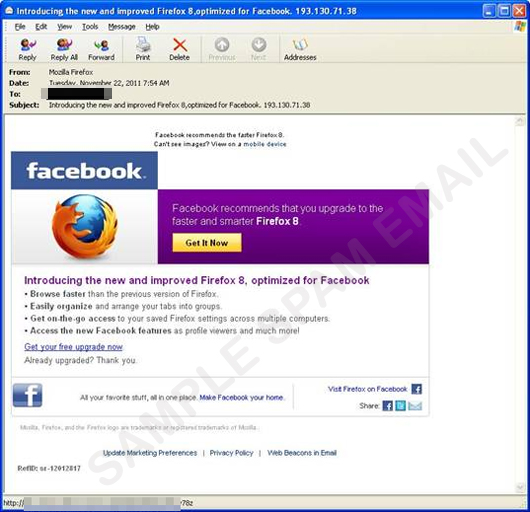TSPY_CARBERP.JG
Trojan.Carberp (Symantec); TrojanDownloader:Win32/Carberp.C (Microsoft); Trojan-Spy.Win32.Carberp.bnv (Kaspersky); Downloader.a!yw (Mcafee); Troj/Carberp-L (Sophos)
Windows 2000, Windows XP, Windows Server 2003


Threat Type: Spyware
Destructiveness: No
Encrypted: No
In the wild: Yes
OVERVIEW
This spyware arrives on a system as a file dropped by other malware or as a file downloaded unknowingly by users when visiting malicious sites.
It also has rootkit capabilities, which enables it to hide its processes and files from the user.
It modifies the Internet Explorer Zone Settings.
It connects to certain websites to send and receive information. It deletes the initially executed copy of itself.
TECHNICAL DETAILS
215,040 bytes
Yes
23 Nov 2011
Downloads files
Arrival Details
This spyware arrives on a system as a file dropped by other malware or as a file downloaded unknowingly by users when visiting malicious sites.
Installation
This spyware drops the following copies of itself into the affected system:
- %User Startup%\igfxtray.exe
(Note: %User Startup% is the current user's Startup folder, which is usually C:\Windows\Profiles\{user name}\Start Menu\Programs\Startup on Windows 98 and ME, C:\WINNT\Profiles\{user name}\Start Menu\Programs\Startup on Windows NT, and C:\Documents and Settings\{User name}\Start Menu\Programs\Startup.)
It drops the following non-malicious file:
- %System Root%\{random folder name}\wndsksi.inf
(Note: %System Root% is the root folder, which is usually C:\. It is also where the operating system is located.)
It adds the following processes:
- explorer.exe
- svchost.exe
It creates the following folders:
- %System Root%\{random folder name}
- %User Profile%\Application Data\MicroST
(Note: %System Root% is the root folder, which is usually C:\. It is also where the operating system is located.. %User Profile% is the current user's profile folder, which is usually C:\Windows\Profiles\{user name} on Windows 98 and ME, C:\WINNT\Profiles\{user name} on Windows NT, and C:\Documents and Settings\{user name} on Windows 2000, XP, and Server 2003.)
Other System Modifications
This spyware adds the following registry entries:
HKEY_CURRENT_USER\Software\Microsoft\
Internet Explorer\Main
TabProcGrowth = 0
Rootkit Capabilities
This spyware also has rootkit capabilities, which enables it to hide its processes and files from the user.
Web Browser Home Page and Search Page Modification
This spyware modifies the Internet Explorer Zone Settings.
Other Details
This spyware connects to the following website to send and receive information:
- http://{BLOCKED}icgamers.com
It deletes the initially executed copy of itself
NOTES:
This spyware may be downloaded from any of the following links contained in email messages spammed by malicious users:
- http://{BLOCKED}.18.186.nw.nuvox.net/mozilla-firefox/rfstiwyz
- http://{BLOCKED}.18.186.nw.nuvox.net/mozilla-firefox/4xe6ypev
- http://{BLOCKED}.18.186.nw.nuvox.net/mozilla-firefox/4rf1y78z
This spammed email, supposed to download an installer of Firefox 8, contains the aforementioned links to download this malware. It may look like the following:

It injects codes into its created processes.
It downloads the following files from its C&C server to aid in its routines:
- miniav.plug - remove certain malware from the affected system
- passw.plug - steal user credentials
- stopav.plug - disable antivirus applications installed on the affected system
SOLUTION
9.200
8.594.09
23 Nov 2011
Step 1
For Windows XP and Windows Server 2003 users, before doing any scans, please make sure you disable System Restore to allow full scanning of your computer.
Step 2
Restart in Safe Mode
Step 3
Delete this registry value
Important: Editing the Windows Registry incorrectly can lead to irreversible system malfunction. Please do this step only if you know how or you can ask assistance from your system administrator. Else, check this Microsoft article first before modifying your computer's registry.
- In HKEY_CURRENT_USER\Software\Microsoft\Internet Explorer\Main
- TabProcGrowth = 0
- TabProcGrowth = 0
Step 4
Search and delete these folders
- %System Root%\{random folder name}
- %User Profile%\Application Data\MicroST
Step 5
Reset Internet security settings
Step 6
Restart in normal mode and scan your computer with your Trend Micro product for files detected as TSPY_CARBERP.JG. If the detected files have already been cleaned, deleted, or quarantined by your Trend Micro product, no further step is required. You may opt to simply delete the quarantined files. Please check this Knowledge Base page for more information.
Did this description help? Tell us how we did.

